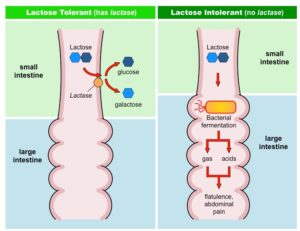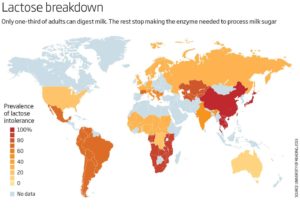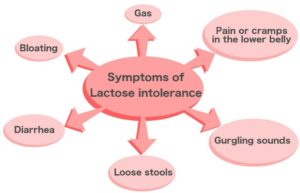By Christian Nordqvist
Lactose is a sugar found only in milk, but it is also present in dairy products and food items made with milk derivatives.
A lactose intolerance is different from a milk allergy. In a milk allergy, the body reacts to milk proteins, not milk sugar. Milk allergy can result in severe symptoms, including anaphylaxis.
A person with a severe lactose intolerance may have to avoid not only milk and milk products, such as ice cream, but other processed foods containing milk powder, whey, and so on.
Lactose intolerance is thought to affect between 30 million and 50 million Americans to some degree.
Symptoms
![[abdominal pain]](https://cdn-prod.medicalnewstoday.com/content/images/articles/180/180120/abdominal-pain.jpg)
A person with lactose intolerance will experience symptoms after consuming milk or some dairy product that contains lactose.
Symptoms can range from mild discomfort to a severe reaction, depending on how much lactase the person produces, and how much dairy produce they consume.
They include:
- flatulence
- bloating
- abdominal pains
- nausea
- diarrhea
The person may have a sudden urge to use the bathroom 1 to 2 hours after consuming lactose. In severe cases, dehydration may occur.
Diagnosis
A person who has symptoms of lactose intolerance is advised to keep a food diary, listing foods consumed, symptoms, and when they appear, before consulting a physician. This can help with diagnosis.
The doctor may advise the patient to try a lactose-free diet for 2 weeks, to see if symptoms improve. If they do, the individual probably has a lactose intolerance.
Some tests can detect an intolerance.

Hydrogen breath test: The patient fasts overnight and then has a lactose solution the following morning. Hydrogen concentrations in exhaled air are measured. High levels of nitrogen indicate lactose intolerance.
Lactose tolerance test: The patient consumes a lactose solution, and then a blood sample is taken to measure glucose levels. If blood glucose levels remain the same, this indicates that glucose has not entered the blood. This is because the lactose has not been successfully broken down into glucose and galactose. In a milk-tolerance test, the person drinks milk instead of a lactose solution.
Stool sample: Lactose tolerance tests and hydrogen breath tests are not suitable for infants, so a stool test may be carried out. High levels of acetate and other fatty acids in the stool can be a sign of lactose intolerance.
Underlying disease or condition: If the symptoms could be due to an underlying cause, such as celiac disease, a small bowel biopsy may be performed. A tissue sample of the small intestinal lining is extracted for testing in a surgical procedure.

Treatment
The best treatment for a person with a lactose intolerance is to avoid foods that contain lactose.
Some people believe that it is more natural not to drink milk, because humans are the only mammals that continue to consume milk products after weaning. Lactose intolerance, they argue, is not a problem but a natural occurrence.
People who do not consume milk products may have an intolerance without knowing it, and without it being a problem.
If a person has an underlying condition, however, it is important to seek treatment for the condition.
Avoiding lactose may require some trial and error, but food labeling can help, as a product that contains lactose must be labeled that it contains “milk.”
The Cleveland Clinic suggests following a lactose-free diet for 2 weeks and then reintroducing foods with lactose, to assess tolerance levels. People with an intolerance, they say, may be able to consume 12 grams of lactose at one time without any effect.
Causes
![[glasses of milk]](https://cdn-prod.medicalnewstoday.com/content/images/articles/180/180120/glasses-of-milk.jpg)
Lactose is a sugar found in the milk of mammals. It makes up between 4 percent and 5 percent of regular cow’s milk, but around 36 to 38 percent of dried whole milk.
Not all mammals’ milk contains the same amount of lactose. The percentage of lactose in reindeer milk is around 2.5 percent, and the milk of the California sea lion contains no lactose.
Lactase is a protein, an enzyme that is produced in the small intestine. The human body uses lactase to break down lactose into galactose and glucose, which is then absorbed into the bloodstream.
If lactase levels are low, the lactose does not break down and it does not absorb into the bloodstream. Instead it moves into the large intestine, or colon. Bacteria in the colon react to any product that contains lactose.
Types of intolerance and deficiency
Lactose intolerance is often inherited.
Congenital lactase deficiency is when a person is born with a genetic mutation that means they produce very little or no lactase.
In familial lactase deficiency, the person produces enough lactase, but it does not break down the lactose absorption into the bloodstream.
Primary lactase deficiency is the most common type of lactose intolerance. It is genetically inherited, and it usually develops before the age of 20 years. Symptoms appear when the person starts to consume less milk, usually when an infant is weaned from milk to solids. Lactase production drops, and symptoms of intolerance appear.
In some people, lactase levels drop from an early age, but the symptoms of lactose intolerance may not appear for several years.
In secondary lactase deficiency, a problem with the small intestine results in too little lactase production. Possible causes are intestinal surgery, Crohn’s disease, ulcerative colitis, chemotherapy, celiac disease and gastroenteritis.
If the underlying condition is chronic, for example, Crohn’s disease, the resultant intolerance is often long-term too. An intolerance that starts with a short-term condition, such as gastroenteritis, normally passes within a few days or weeks.

Foods to avoid
Most milk and milk products have lactose in them, and many processed foods have milk and dairy products added to them.
Any product with milk, lactose, whey, curds, milk by-products, dry milk solids or non-fat dry milk powder listed in their ingredients will have lactose in them.
Foods that commonly contain lactose include:
- cakes and biscuits
- cheese sauce
- cream soups
- custard
- milk chocolate
- pancakes
- scrambled eggs
- quiche
A person with a lactose intolerance should check food labels carefully, as some foods may contain“hidden lactose.”
Examples include:
- muesli bars
- breads
- breakfast cereals
- margarine
- some instant soups
- boiled candies
- chocolate candies and bars
- some processed meats, such as sliced ham
- salad cream, salad dressing, and mayonnaise
Ingredients to look out for on a label include milk solids, non-fat milk solids, whey, and milk sugar.
Around 20 percent of prescription medications, such as birth control pills and around 6 percent of over-the-counter drugs, for example, treatments for stomach acid, contain lactose.
People with a severe lactose intolerance should tell their doctor or pharmacist about this when obtaining new medications.
Alternatives to dairy milk include almond, flax, coconut, or soy milk. Grocery stores often stock a range of lactose-free alternatives to various products.
It is safe for women with a lactose intolerance to breastfeed an infant. It will not make the infant sick or increase the risk of intolerance, and breast milk has important benefits for growth and development.
Alternatives to dairy
In many societies, dairy products are an important source of calcium, protein, vitamins A, vitamin B12 and vitamin D. Cutting out dairy products may lead to malnutrition, unless they are replaced with foods of similar nutritional content.
![[almond milk]](https://cdn-prod.medicalnewstoday.com/content/images/articles/180/180120/almond-milk.jpg)
Alternative sources include:
- Calcium: Seaweeds, nuts and seeds, blackstrap molasses, beans, oranges, figs, quinoa, amaranth, collard greens, okra, rutabaga, broccoli, dandelion leaves, kale, and fortified products such as orange juice and plant milks
- Vitamin A: Carrots, broccoli, sweet potatoes, cod liver oil, liver, spinach, pumpkin, cantaloupe melon, egg, apricot, papaya, mango, and peas
- Vitamin D: Levels can be enhanced by exposure to natural sunlight, consuming fatty fish, eggs, fish liver oils, and some fortified plant milks and other fortified products
- Lactose-free milk: A person with severe symptoms should check the label to ensure that lactose levels are zero, and not just reduced. Vegetable-based milks also contain less proteinthan cow’s milk
According to Nutrition Australia, most people with lactose intolerance do not need to avoid all dairy products.
Even those with low lactase levels can normally tolerate up to 12 grams of lactose a day, they say, or one cup of milk. Spreading consumption throughout the day, and taking it with meals, can increase tolerance.
Anyone who is considering changing their diet should first consult a doctor or a registered dietitian for advice.
A true love for sports


Recent Comments